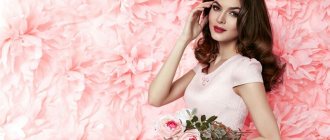Origin of color
The name “violet” entered the Russian language back in the 18th-19th centuries. Initially, the Latin word viola, which means violet (which, by the way, is where the name of the flower of the same name comes from), began to be used in Western Europe, in particular in France, as couleur violette or “violet-colored.” In Polish, this phrase was pronounced as fioletowy and it was in this version that it reached the Russian-speaking peoples.
Violet appears in the visible light spectrum and is the last and darkest of the primary spectral colors. This is a second-order color, i.e., obtained by mixing cold blue with warm red. In combination with the incongruous, a noble, mysterious and complex shade is born.
Important! Despite the fact that the basis of violet is a warm red color, violet is still classified as cool tones.
Violet unites and creates a balance between body and soul, between demonic passions and life wisdom, between the divine and the earthly. The task of violet is to direct attention deep into oneself, to connect with the subconscious. Psychotherapists use this color to determine how stable a person’s psyche is.
Black
© Pexels
Black represents mystery and the unknown
.
If you don't like the color black, it means you are often indecisive.
.
You are sometimes afraid of taking the wrong step, you may hesitate a lot for fear of making a mistake, and you waste too much time and energy making a choice.
You are a good-natured and friendly person
, you are not characterized by excessive seriousness or conservatism.
Perhaps black seems like a depressing color to you, given that you have a more carefree and optimistic outlook on life.
You do not like power and control, you have a soft character.
You may have had a fear of the dark
that you can't get rid of. It's also possible that you had an overbearing parent or were instilled with fear as a child, and black brings back those memories.
The legend of the appearance of purple
When Melqart, the god and patron of navigation, was walking along the seashore, his dog found a large shell, picked it up and the dog’s fur instantly turned into an unusual color never seen before. Delighted, Melkarta's beloved asked to get her such paint for a dress, for which God collected every single shell from the seabed and gave it to his beloved. Since then, people began to take shells from the depths of the sea and carefully place them on the shore. Each shell contained just a drop of precious divine purple dye.
Links[edit]
- DeFalco, Tom; Sanderson, Peter; Brevoort, Tom; Teitelbaum, Michael; Wallace, Daniel; Dear Andrew; Forbeck, Matt; Cowsill, Alan; Bray, Adam (2019). Marvel Encyclopedia
. DK Publishing. item 283. ISBN. 978-1-4654-7890-0. - Rowin, Jeff (1987). Encyclopedia of Super-Villains
. New York: Facts on File. item 282. ISBN. 0-8160-1356-X. - Alpha Flight
#41. Marvel Comics - Alpha Flight
#48. Marvel Comics. - Nickname
# 24-28 (2004) - Nickname
# 26–28 - Nickname
# 28 - New Avengers
vol. 1 #01–03 (January–March 2005). Marvel Comics - New Thunderbolts
# 10-12 (2005) - Avengers Academy
#3. Marvel Comics - Jump up ↑ Thunderbolts
#147. Marvel Comics - ^ a b Fear Itself: Home Front
#1. Marvel Comics - Heroes for Hire
(2010) #9–10. Marvel Comics - Villains for Hire
#1. Marvel Comics - Daredevil
Vol. 5 #20 - Jessica Jones
#17. Marvel Comics. - Jessica Jones: The Purple Daughter
# 1 - Marvel 1602
# 3 - New Thunderbolts
[
volume and issue required
] Marvel Comics - "David Tennant Joins Marvel's Jessica Jones for Netflix". Marvel.com. January 26, 2015. Archived from the original on January 28, 2015. Retrieved January 26, 2015.
- Dahl, John (Director); Jamie King and Dana Baratta (writer) (November 20, 2015). "AKA Sin Bin." Jessica Jones from Marvel
. Season 1 Episode 9 Netflix. - Petrarch, David (director); Liz Friedman and Scott Reynolds (writer) (November 20, 2015). "AKA it's called whiskey." Jessica Jones from Marvel
. Season 1 Episode 3. Netflix. - Rymer, Michael (Director); Scott Reynolds and Melissa Rosenberg (story); Jamie King and Scott Reynolds (writer) (November 20, 2015). "AKA Smile." Jessica Jones from Marvel
. Season 1 Episode 13. Netflix. - Lynch, Jennifer (Director); Jack Kenny and Lisa Randolph (writer) (March 8, 2021). "AKA Three Lives and Counting." Jessica Jones from Marvel
. Season 2 Episode 25. Netflix. - https://ew.com/tv/2017/08/14/jessica-jones-david-tennant-season-2/
- https://www.radiotimes.com/news/on-demand/2019-06-18/is-david-tennant-in-season-3-of-jessica-jones/
History of the use of purple in ancient times
In Ancient Greece, purple (which is where the history of purple began) was obtained from three types of shellfish, which had to be collected and processed in huge quantities. Phenicia was especially famous for the production of rare paint; it is not for nothing that the name of the state in translation means nothing more than “the land of purple.” Phoenician craftsmen could achieve absolutely incredible, unique shades of purple. Due to the labor-intensive and lengthy process, purple clothes cost incredible amounts of money, and only very rich people could afford them. Roman historian of the 1st century. n. e. Pliny the Elder wrote about the color purple: “There is no doubt that it is the color of triumph, which is why everyone is so crazy about it. But is it really right that it costs so much money if it smells so disgusting?”
Important! A half-meter piece of purple silk in today's currency cost about 28 thousand dollars. Dyed wool and fine linen imported from Egypt would be a little cheaper.
Symbolism of purple
Because of its ability to harmonize and balance polarly different colors and emotions - the passion and fatality of fiery red with the serenity and calm of cold blue, as well as the creation of something new, purple has always been considered the most mystical and mysterious color. This is the personification of the cosmos, everything unknown, unearthly and far from worldly reality. For this reason, in myths and legends of all times, wizards, sorcerers and astrologers wore purple clothes. The appearance of this shade in a dream is considered a favorable sign and indicates impending major changes in life.
Important! In the science of bioenergy, plants with a violet aura are credited with the ability to cleanse the human biofield of negative energies.
The color purple symbolizes:
- wisdom, therefore the shade is often associated with a night bird with secret knowledge - the owl; - loneliness, melancholy, hence in some nations purple clothes are worn for mourning ceremonies; - humility and a sense of proportion, therefore at all times it was believed that a ring with a purple stone would protect the clergyman from worldly temptations; - isolation, modesty, because one of the properties of color is to hide from prying eyes, not to put on public display; - knowledge, therefore purple is used in science as a color that inspires search, creativity, and activates mental activity; — borderline state, because purple can induce a person to relax, meditate, and even immerse him in hypnosis, which is why the color is actively used in spiritual practices and magic; - divinity, exclusivity, because previously only the altar Bible was allowed to be purple, and only St. Anna and the Mother of God, as a sign of deep respect, were depicted on icons in purple robes; - luxury, imperial dignity, due to which previously only monarchs could wear purple robes and boots, sign documents with ink of this shade, and sit on a purple throne.
Important! Senators were allowed to wear a purple belt or decorate elements of their clothing with a purple border, which indicated their special position in society.
People's attitudes towards purple have changed over time. He was the flower of the “creators” obsessed with new ideas at the end of the 19th and beginning of the 20th centuries. In the 60s purple clothes were worn by “hippies” as an attribute of those who knew the true meaning of existence. In the 80s purple again, as in ancient times, began to represent luxury and wealth. In our time, this color is associated with creativity, a riot of imagination, originality and richness of the inner world.
Significance in psychology
In most cases, the color purple has a beneficial effect on a person’s mental and physical state.
1. Facilitates immersion in a trance and opens deep layers of memory, memories drowned out by consciousness. Improves concentration. 2. Promotes relaxation, reduces stress, helps with insomnia. And the effect of soft purple shades on a person affects the quality of sleep, making it deeper and more peaceful. 3. Helps restore peace of mind and look at problematic situations in a new way without excessive anxiety. 4. Helps reduce appetite. 5. Has a beneficial effect on the pituitary gland, spleen, endocrine and lymphatic systems, reduces blood pressure, improves vision and hearing. Used as restorative color therapy after surgery and injuries to internal organs and tissues. It has a narcotic ability to reduce pain.
Important! If a nearsighted person looks at the color violet for a few minutes every day, his vision will improve.
In addition, violet develops sensitivity, promotes the search for ways to achieve global goals, the development of artistry, intuition, and inspiration. Sets you in a romantic mood, evokes unconditional love and nostalgia, compassion for your neighbor.
Important! It is believed that people who are partial to the color purple unconsciously want to please the opposite sex.
Thanks to its ability to balance and calm, slow down breathing and heartbeat, which purple does better than other colors, it helps in therapy for people with vegetative-vascular dystonia and those suffering from astheno-neurotic syndrome and cope with sudden anxiety and panic attacks. Color is also effective in treating psychological injuries.
Brown
© pixabay
Brown color is associated with durability, reliability, safety
.
If you chose brown as your least favorite color, then you can be called a sociable person, striving for pleasure and fun
.
You are an imaginative dreamer who loves to have your head in the clouds.
Everyday life and monotony quickly bore you, and you are not looking for a quiet life.
You are spontaneous and often have fresh and original ideas.
. You are witty, impulsive and generous.
It is difficult for you to find language with conservative and down-to-earth people, and you are looking for like-minded friends.
For women
Dark purple color acts as an aggressor on women. With constant exposure to it, representatives of the fairer sex experience frequent mood swings, when a surge of energy gives way to an attack of melancholy. Light lilac and lilac shades act opposite to dark ones - they relax and instill romanticism and dreaminess. Purple tones help develop self-confidence as a woman. Such a lady will desire male attention, but only for recognition, and not for a serious relationship, because she will be quite comfortable being alone with herself.
Orange
© homydesign
Orange symbolizes sophistication, warmth and empathy
.
If you didn’t like the orange color at first glance, then perhaps you recently experienced an insult or regret something you said
.
Perhaps there was a situation in which someone accidentally dropped a word, but since you are a rather thoughtful person, this could seriously hurt you. You can be called a rather vulnerable person.
You are not very comfortable in large groups, preferring a close circle of friends
. You are not attracted to parties and noisy events, since pretense and the desire to impress are alien to you. You try to stay away.
A dislike of orange also often indicates inner anger
related to abuse at some point in your life.
For children
More often, purple has a depressing effect on the child’s psyche. This is the color of children who are insecure and poorly adapt to new living conditions. If violet shades predominate in a child’s drawings, then this is an alarming sign for parents. The purple color speaks of the child’s possible hidden depression, a desire to escape reality into his own imaginary world.
It should be remembered that a child’s nervous system is formed before the age of 5; young children simply like bright colors, including purple. Therefore, it is too early to draw conclusions about the mental health of children under 5 years old based on the drawings.
Green
© Pexels
Green represents harmony, health, growth and generosity
.
If you chose green as your least favorite color, then perhaps you have recently encountered a situation where you were deceived or betrayed
.
Your greatest difficulties are probably
. Whether it concerns friendships or romantic relationships, you often feel like few people truly know you.
When you communicate with others, you are often visited by a feeling of disappointment, and this makes you move away from people.
People often feel that you are building a wall between yourself and others. You are a loner who keeps a lot to yourself, doesn't like to blend in with the crowd, and doesn't want to do what most people do.
Negative effects of color
The saying “a lot is not a good thing” is very suitable for situations when the energy of violet affects a person negatively. An excess of purple color can be dangerous, first of all, for the emotional state, because it can put pressure on the psyche - it can cause melancholy and indifference to what is happening or, conversely, increased anxiety. A person will unreasonably begin to make excessive demands on himself; habits such as painful self-control and self-flagellation will appear in his character, which can ultimately lead to depression. Moreover, in people with low self-esteem, with excessive exposure to the color purple, it will decrease even more.
Pink
© Getty Images Pro
Pink represents romance, playfulness and childishness
.
If you hate the color pink, you might be considered a straightforward and unyielding person.
.
The color pink seems sweet and too feminine to you. You are intolerant of pretense and coquetry in any form and are capable of being firm if the situation demands it.
You are not inclined to show empathy and care towards people.
On the other hand, you have unresolved emotional problems
with one of the parents who stretches back from childhood.
Deep down, you miss joyful experiences and vibrant activities in life.
Shades of purple
Real purple color is dark, deep and rich. But in nature it practically does not occur; much more often you can see mixes that lead either to the warm red range or to the cold blue range. Moreover, despite the fact that white, black and gray cool colors can also be an admixture of purple, warm purple shades are still in the overwhelming majority.
Important! It is believed that light, soft pastel colors have a more beneficial effect on the human psyche than aggressive dark ones.
Dark purple. One of the darkest shades of the palette is the color of the abyss, losing its beginning and end and going into the depths of infinity. Purple denotes the secrets of the universe, black - animal, primal fear. Dark purple makes you tremble with anticipation of a miracle on a universal scale. Cold detachment, severity and restraint, this is what this color is associated with.
Black and purple. Despite the fact that black is associated with sin, devilry and death, black-violet is a fundamental color, a shade of stability and constancy. The color of deep night, associated with the otherworldly, devilish world. Together with purple, the shade takes on a mysterious character. At the same time, there is no anxiety in it, it is not depressing, as it might seem initially.
Purple blue. The fantastic color of twilight, in which the subconscious itself draws the vague outlines of images. Purple in this shade is the color of the unconscious, and blue is the color of the incomprehensible, and together they form fantasy, space, isolation from reality, a fairy tale with its magical characters: mermaids, gnomes, elves and werewolves.
Purple-red. If purple means detachment from the worldly and calmness, then red, on the contrary, involves and forces you to take active actions. Purple-red is the color of sexual desires. And if purple itself has a stimulating effect, then in combination with violet it awakens deep subconscious, sophisticated desires, which in a certain sense can even be dangerous.
Purple. Combining the two opposites of red and blue, purple becomes a shade of balance, but at the same time duality, awareness and restraint, but at the same time lust. Purple represents the feminine and masculine. Shows the path from base instincts to enlightenment and achievement of the final stage of personality formation, as a person created in the likeness of God.
Grey-violet. Purple, filled with the mysteries of the universe and the sounds of space, in combination with a modest and calm gray color, becomes more down-to-earth, ordinary, although no less detached and lonely. The gray-violet hue is ideal for people who seek privacy and want to hide in their shell, while also being gifted creative individuals. In nature, gray-violet can be found in stormy skies, on stones that have been lying on the ground for thousands of years, in the form of poisonous mushrooms. This shade seems to take us into eternity, but earthly, making us think about the versatility and breadth of the universe.
Lilac. This is the color of femininity, calmness, peace, it relieves irritation and puts you in a romantic mood. Along with the lavender shade, lilac is enchanting. This is the color of magical adventures, filled with fairy tales, love experiences and spring with its crazy floral scents.
Blue
© pixabay
Blue color symbolizes freedom, stability and reliability
.
If you don't like the color blue, you're probably at a point in your life where you want to escape reality.
. You don't want to be tied to circumstances, and you crave freedom.
The current situation makes you feel constrained and limited
more-less. This could be a stressful situation at work or emotional pressure from a partner.
Disagreements and misunderstandings make you want to escape to an imaginary paradise where there are no unpleasant people and situations.
Also, a dislike for blue indicates that you do not like routine and are in search of new experiences.
. Perhaps you're just tired of responsibility.
Who likes the color purple?
The main quality of people who choose purple as their favorite color is inconsistency; there is always an internal conflict in them. They are not like everyone else and see the surrounding reality in their own way. Their personality is multifaceted and combines impressionability with self-confidence. Such people are attracted to more subtle matters, attracted by everything mysterious, and have little interest in material things.
Important! More often than not, people who prefer purple to all other colors find it difficult to realize themselves in life, both personal and professional.
Pedants are passionate on the inside, but outwardly they often behave with restraint. They are prone to melancholy, prone to depression, and acutely perceive negative moments that happen in the world around them. These are humanists and fighters for justice who do not find it in real life. Because of this, “purple” people often withdraw into themselves, and from the outside they can look gloomy and even embittered. They prefer loneliness, are prone to self-examination and, through introspection, discover new facets of their “I”. Such people constantly seem to evaluate themselves from the outside.
“Purple” people are sensitive and modest, they will never offend the weak and will not refuse help. Wise, but at the same time easily susceptible to other people's influence, driven and trusting. Lovers of purple avoid arguments and do not prove their point of view, but in a critical situation they are able to defend their opinion.
The main traits of “purple” people:
- phlegmatic character; - pessimism; - daydreaming; — soul-searching, increased interest in the inner world; - excessive self-control; - heightened sensitivity and vulnerability, touchiness; - softness and pliability; - kindness and caring.
In addition, people who prefer a purple tint are most often childish and internally immature; it is not for nothing that teenagers are partial to the color purple.
★ FnaF [Rus]
Let's talk about the main hero of the occasion, without whom the FNAF plot, and with it numerous theories, would not have existed. A crowd favorite, serial killer, father of the year and just a good guy, let's welcome: Purple Pixel Man!
I'll start with the main thing right away: his name is not Vincent. His real name is William Afton, both in the book and in the games.
Vincent is a name invented by fans and adopted by the fandom due to the lack of canon information on this matter. Just like Phone Guy's name is Scott. In fact, we don't know what Phongai's name is, it's just established fanon.
What we know about William from the games, besides the fact that he is a killer, is that he has a British accent, three children (spoiler: they all died) and an animatronics company, and he also became Springtrap. Not a lot, but until the fifth part we didn’t even know his name, so it’s a sin to complain.
And now a little about the bookish William Afton. Aka Dave Miller, aka The Purple Man. This is the description given to him at the first meeting:
“There was something disconcerting about the guard’s appearance. Tall and very thin, he gave the impression of being seriously ill or having experienced a terrible tragedy: his uniform hung on him as if on a hanger, as if he had lost a lot of weight; On his chest dangled a crooked badge with the inscription “DAVE.” The sallow skin and deep wrinkles under the eyes reinforced the resemblance to a seriously ill person. ... His whole appearance showed some kind of insufficiency. Such a person will always be pushed to the end of the line, shouted down in an argument, and will always be bullied by the more energetic, those who cling more tightly to life.”
And here he is in front of his potential victim, the guy Afton stuffed into one of the flimsy spring suits:
“At the first meeting, Dave seemed homely to the young man, emaciated and weak, but now, dressed in a rabbit suit, he looked completely different. The face remained the same: the same sharpened features and sunken eyes, and the skin seemed to have become so painfully thin that it looked like it would burst at the slightest strain. Only now Dave’s entire appearance was filled with an evil, wild force, a kind of rat-like vitality. ... Now before Carlton stood a man who had lived the life of a cornered rat for so long that sadistic tendencies had become an integral part of his being. Such a one will gladly grab you by the throat and will revel in the suffering of others, and will also be sure that he has every right to do this - after all, everyone always owes him.”
This scene is also notable for the fact that after a colorful description of what happens to a person after the spring locks are triggered (in the Russian translation they were called clamps), to the question: “How do you know?”, Afton replies: “Guess,” and undresses:
“The guard’s skin was covered with numerous scars, raised white scars arranged symmetrically: the pattern of scars on one half of his body was mirrored on the other half. ... The sides and back were also covered with a network of scars, like a thin lace shirt. The scars reached his waist and probably ran down his legs, now hidden by the suit. Most of the scars were at the base of the neck, where they were larger and more noticeable; two rows of scars ran along both sides of the neck to the back of the head and were hidden under the hair.”
From which it becomes clear that William has already become a victim of spring locks, but he does not stop wearing the SpringBonnie suit. Looks like this guy doesn't learn anything from his mistakes.
And look at how William Afton 1987 is described:
“Of the two of them, Afton gave the impression of being the most normal, a kind of shrewd businessman. ...William Afton managed Henry's business, and he also ran everything at the first diner. Afton was the complete opposite of Henry: the former was tightly built and energetic, the latter was gloomy and withdrawn. Afton was a big, gregarious man with the same complexion as Santa Claus. He killed those children. ... Afton was nearby during all the abductions and mysteriously disappeared instantly at the same time as the missing children. During a search of his house, they found an entire room crammed with boxes of mechanical parts, a moldy yellow rabbit suit, as well as piles of personal diaries, in which a huge number of pages were dedicated to Henry: at first Afton was terribly jealous of the inventor, then the envy gave way to manic adoration, almost worship "
This is despite the fact that of all the elements of the books, Henry fits into the universe of the games as organically as possible. And after the release of FNAF 6, he completely joined the canon of the gameverse.
Now let's continue :)
If we talk about the motive that prompted the book William to kill, then everything is described quite vaguely, so I cannot give a quote. But in short, he was lonely and wanted to create a family for himself this way.
For William from the games, such motivation is not suitable: as you remember, he already had three children. Who died, which, in my opinion, was the trigger for William.
Of course, there is a possibility that William became a killer before he started a family, simply having children of his own curbed his desire to kill - up to a certain point.
And, since we're talking about Afton's children, let's take a closer look at them.
The eldest is Michael Afton, the guy in the Foxy mask from FNAF4, Eggs Benedict from FNAF5 and possibly Mike Schmidt, Fritz Smith, the guard from FNAF 3 and the main character of FNAF6. By the way, from the “Survival logbook” it becomes known that it was he who dreamed of nightmare animatronics. As a teenager, he killed his younger brother. Having matured, Michael got a job as a security technician in his father’s company. After working for a week, he fell victim to a scooper and was used by Ennard as a ceremonial costume, but did not die and, having vomited the animatronics into the nearest sewer, continued to exist as a purple zombie (when I say “zombie” I am exaggerating somewhat. Michael did not die and was resurrected, but he just didn’t die. Judging by the “Survival logbook”, he still needs sleep, food and coffee. And if we assume that in FNAF3 we also play as him, then breathing). From the same “Survival logbook” you can find out that Michael draws well, considers constantly chewing gum to be his bad habit, and has a rather dark sense of humor.
Afton's daughter, the ice-cream girl, the red-haired girl. From FNAF6 her name becomes known - Elizabeth. She became a victim of Baby and after her death moved into her body. In SL, Baby is the only animatronic with a soul. And Ennard is her too. A sweet girl who loves ice cream and has gone a little crazy after her own death and imprisonment in an animatronic. It's a little strange that she didn't recognize her brother, who also looks a hell of a lot like their father, but oh well. But she very touchingly persuaded him not to die in that cutscene. Afterwards, she didn’t share something with the rest of the animatronics, and left Ennard, transferring control of it to Funtime (Molten) Freddy. She assembled herself a new body from all sorts of garbage and what she did for the next 30 years before FNAF6 is unclear.
Afton's youngest son, aka the Crying Child, aka the Bitten One. Real name unknown. The main character of the FNAF4 minigames. At his birthday party, Fredbear breaks his skull because of his older brother. After one terrible week, he dies in the hospital. But what happened to him next? In a universe where murdered children tend to inhabit robots, this question is quite relevant.
Firstly, he could just die and that’s it. But it's boring and doesn't fit the spirit of the games. He could possess Golden Freddy, but then the question arises, where did the fifth of the missing children go? Found yourself thrown out into the cold? Unclear.
A person who is bitten can still end up in Golden Freddy without breaking the number of missing children. It's a matter of reference point: the five missing are not the main four plus Golden Freddy, but the main four and the Puppet. Then Golden Freddy's place remains vacant and Bitten can take it. Plus, a mini game “Happiest Day”, where the ghosts of children give a birthday cake to one of them, after which he puts on a Golden Freddy mask and they all disappear, and balloons are sent into the sky. And who died on his birthday (actually a little later, but let’s not quibble over details)? That's right, Bitten. SYMBOLISM.
But the Puppet is not a missing child; her corpse was thrown literally a couple of meters from the entrance to the pizzeria. She should have been found, if not on the same day, then the next. Plus, her father is well aware of the circumstances of her death. So Puppet can't be the fifth missing child, and Bitten can't be Golden Freddy. Sorry baby, the seat is busy.
Another option is to turn Bitten into Shadow Freddy.
Shadow Freddy is one of the most mysterious animatronics. He can be seen in FNAF 2 on the sixth night, sitting in the same position as Golden Freddy (aka Fredbear, who caused the death of the bitten one). And the model of Shadow Freddy is Golden Freddy repainted purple. And then, in one of the FNAF3 mini-games, he invites the classic animatronics to follow him, leading them to the FF for disassembly. Which allowed the souls of the children to free themselves and drive the FF into Springtrap. Yes, it is generally accepted that Shadow Freddy, like Shadow Bonnie, are unlucky employees of Fredbear's family dinner who got caught in the wind. But this is not a canonical fact, just one of the theories accepted by the majority. In addition, many people wondered why Shadow would help the ghosts of children. And so, everything is more or less clear. He helps not the ghosts of the children, but the father. And the fact that the result turned out to be terrible... Oops, it happens.
The main argument of opponents of this theory sounds like a question: if Shadow Freddy is Bitten, then who is Shadow Bonnie? I answer: he could still be a sprung employee of Fredbear's family dinner. There is nothing stopping this.
In connection with the release of FNAF6, another theory has appeared, which I like, but, alas, is poorly provable. Bitten - Molten Freddy. William promised him “I will put you back together.” So he returned it - first in the form of Funtime Freddy (it is noticeable in the drawings that he has room in his stomach for a child or for the corpse of a child), then as Molten Freddy. That's why the remnants of Ennard call themselves Freddy, and not Foxy or Ballora - whoever has the soul runs the party. And this is also SYMBOLISM - because then, it turns out that Henry in FNAF6 gathered all the Aftons under one roof. And he burned them, ending the story. The disadvantages of this theory are that if the Bitten One possessed Funtime Freddy, he would somehow manifest himself in FNAF: SL. This is a great way to put even more pressure on Michael - he clearly regrets the death of his brother. The option remains that the Bitten One clung to Molten Freddy already in the post-Ennord period, but how? Unclear. But the theory is still beautiful and does not throw the murdered children out into the cold.
Finally, a few words about Mrs. Afton. We know about its existence only from indirect evidence: William himself gave birth to three children? And nothing is known about her fate. She may have abandoned her family after the birth of her last child. Or realizing that William loves Henry much more than he loves her. Or after the death of the Bitten One or Elizabeth. Or realizing that something was wrong with William (but in that case, why did she leave him the children?). Or William realized that she realized that something was wrong with him and killed her, stuffing the corpse into Ballora, but this version seems very unlikely to me - Ballora, like all Funtime animatronics, except Baby, does not show any signs of obsession with a vengeful ghost. In general, her fate remains entirely in the power of the ficwriter, go for it!
As I wrote above, in the gameverse the Aftons almost the entire family burns to death in a pizzeria at the end of FNAF6. Why almost? The fate of Mrs. Afton is still unknown; Molten Freddy may not be Bitten; Michael could have survived - Henry had provided an escape route for him, but decided that Michael would not want to use it, so if Michael suddenly changed his mind about dying, he could escape.
Men
Intellectuals with a keen eye for observation. In life they notice more negative things, that is, they think in a pessimistic way. They are kind, understanding, but do not like to give advice, because they believe that a person should be responsible for himself and decide what to do. They love independence in everything, so they set the rules by which they live themselves. Men who prefer purple are aesthetes by nature. Although they may come across as vain and arrogant, they usually are not. They rarely say what they think, but their facial expressions reveal their true thoughts.
Yellow
© Pexels
Yellow represents brightness, positive emotions and joy
.
If you don't like the color yellow, it may be because you've recently encountered some difficulties or troubles.
In my life. This may be one of the reasons why you don't feel like interacting with others or expressing your emotions openly.
You have a tendency to avoid conflicts with people.
You can be called a practical and down-to-earth person
who is not always ready to accept changes in his life. You prefer to keep your feet firmly on the ground and are skeptical of new ideas until you are convinced of their rationality with your own eyes.
You tend to think things through before you take a step.
You cannot be called a spontaneous or impulsive person.
If you cannot find a solution to a problem or a way out of a situation, it is difficult for you to turn to others for help. This is one of the reasons why you often experience depression in silence.
Women
Women who love the color purple are dreamy and ephemeral; it’s never boring with them. They live in their own reality, understandable only to them, and are guided by their own principles and rules. Moreover, such people never break the law and are very conservative. They do not strive for power, but since they have developed intuition, they are often useful in distributing advice to the person “at the helm.” They are prone to mood swings, going from one extreme to another, from panic to euphoria. They are vulnerable, sensitive and emotional, although outwardly they try not to show their vulnerability. Such women need the patronage and protection of a “strong shoulder.”
Red
© Getty Images Pro
Red represents positivity, energy and enthusiasm
.
If you don't like the color red, then you are most likely currently experiencing stress at work or in your personal life.
may be afraid or lack self-confidence
, you are not ready to open up to new opportunities that come your way.
It could also mean there is some discomfort or frustration that is causing you to lose motivation to work, or you are struggling to find a goal to focus your energy on.
People who don't like the color red often have difficulty dealing with anger
. They are faced with feelings of rejection or defeat at an early age and lack self-confidence.
You may experience general fatigue or illness, and need peace and rest more than activity.
Think about all the successful moments in your life, try to establish connections with loved ones and friends, allow yourself to be loved in order to gradually regain self-confidence.
Using purple in clothing
Clothing in purple shades creates a mysterious image, suits romantic natures, but at the same time speaks of the inaccessibility and restraint of the person wearing it. A representative of the fairer sex who wants to be noticed will certainly choose an outfit of this color. Clothes of this shade would look appropriate on a woman expecting a child, since purple promotes a more harmonious transition from the state of pregnancy to the status of mother.
Important! A lonely lady in a purple robe subconsciously shows that she is ready for a serious, long-term relationship.
A man in a purple suit will look respectable and status-worthy. After all, this color is chosen by serious, intellectually developed representatives of the stronger sex, who value decency in people and are such themselves.
Teenagers who want to be independent of the opinions of other people, but at the same time still remain children and believe in the power of magic, also love clothes in purple shades.
But it is extremely undesirable for young children to use purple in their clothes. It has a very aggressive effect on the child’s still fragile nervous system, suppressing his psyche. Especially the last statement concerns dark tones.
Important! It has been noticed that purple clothes make people look slimmer.
In order to accurately find “your” shade of clothing in the purple palette, you need to be guided not only by personal preferences, but also take into account the features of your appearance:
- Blondes are best suited for dresses in pastel pale colors; - girls with fair skin and blue or gray eyes should take a closer look at violet and lavender shades; — brunettes can opt for darker, rich tones of purple; — Brown-haired women are ideally suited to purple-colored clothing.
Lightweight items made of chiffon, as well as everyday clothes such as shorts, T-shirts, etc. look better in light colors, but expensive evening suits and dresses, clothes made of silk, velvet, brocade look rich and solemn in dark colors.
Use of color in the interior
The result of using purple in the interior will depend not only on the color itself, but also on its dosage, place and form of application, combination with other shades and the overall style of the room. Thus, in a classically executed interior and in the Provence style, light, delicate shades of purple look good, while in a modern style, pop art, hi-tech and minimalism, dark, bright and rich tones will be relevant. It must be remembered that dark purple is a difficult color to perceive, so it is recommended to use it as accent spots in very measured quantities. You also need to think carefully about the lighting system so that the room does not seem too gloomy.
Important! It is better not to use red in tandem with purple in interior design, because this combination has a stimulating effect on the psyche.
Exaggeration
There are many ways to exaggerate character details, increasing or decreasing them depending on what suits your character best. You can enhance their facial expressions, gestures and even physical form, which we will discuss in detail. Any of these techniques can enhance the story by clearly conveying emotion or action.
When creating a character, it is important that the audience knows without a doubt what type your character is. In film and animation, there is sound that sets the mood. Since illustration lacks these details, we must use other tools to convey the intent: composition, lighting, color, etc.
In other words, our task is to show, not tell. What better conveys the moment - a caption that says that the main character feels defeated after yet another failure, or showing this feeling through facial expressions and body language? It is important to study realistic anatomy and proportions - and only then delve into the exaggeration of the character. It is necessary to know how the human body works before you begin to stretch and change physical shapes. A simplified diagram of the proportions of the human body can be studied in the previous material in the series.
Let's look at a few examples.
Big arms and shoulders
When the arms and upper body musculature are pushed to the extreme, what does that say about the character? We might think that the character is strong, dominant, tough, maybe even heroic.
If you combine these large hands with a strong physique, these qualities will be supplemented by reliability, since the character will have good support. He can be relied upon and is not easily knocked down.
Large hands
What about characters with large hands?
Maybe they have strong "man arms", which would especially stand out if this is a physical characteristic of a woman. Such a character may be creative or tactile, and may love manual labor. Or he may seek control. Or maybe the character's arms have some really cool power, like it looks like in the image above.
Thinness
The character can be very thin.
Then we can say that he is quite fragile, passive, so sometimes he may seem weak-willed. He may be quiet or timid. Such a character could potentially be weak.
Large feet
What do large, strong legs mean then?
Reliability, unshakable strength. Such a character will be strong and assertive. He is able to stand up for himself, and can also be quite still.
Big ears
If a character has big ears, they might be a little awkward, like Dumbo, and might get teased for having huge ears.
Or maybe he just has really good hearing. Which can lead to him being more understanding and curious because he hears a lot more than others.
Big glasses
Another telling detail can be large glasses.
Smart characters and nerds are often depicted with big glasses. Maybe this character likes to read, or maybe he just has very poor eyesight. He could potentially be an introvert, which would fit with the idea that he relies more on intelligence and analysis than brute force.
Volume hair
Hair can also be extremely expressive. The character can be wild and groovy - look at her voluminous, crazy curly hair:
The character can turn out to be joyful or more passionate - look at the curls in the picture below, the chosen color also helps the image:
Or the character could be more endearing. Lots of waves and curls show him happy and cheerful.
And long, smooth hair will make the character calm and mysterious. So they can also play an important role in design.
When approaching exaggeration in character design, keep in mind that their form and mannerisms should be tailored to their unique personalities, experiences, and skill sets. More often than not, you'll want to make some traits stand out more than others, depending on the character's personality. However, emphasizing traits that conflict with his skill set can also make a character unique. Someone with whom people can identify.
Use of color in advertising
Purple with yellow or gold is used in advertising to attract the attention of creative audiences. In addition, shades of purple can be found on the packaging of products that contain components of this color, for example, purple flowers or berries. Purple is often used in advertising of luxury goods in order to emphasize their significance and uniqueness. In advertising of esoteric services, purple acts as a symbol of self-knowledge. The lilac shade goes very well with pink, which is traditionally considered girly and is therefore used in advertising for girls' products and products intended for child care. Purple and lilac can be seen in commercials for women's perfumes and perfumes. These shades look most advantageous in glass, which gives them special depth and tenderness.
Combination with other colors
Dark, rich purple goes well with lighter, calmer shades. The new tone, formed from a combination of purple with other colors, is endowed with a completely different, unique idea and meaning.
Purple with pink is a harmonious combination, since most shades of pink come from purple, for example, lilac, magenta, fuchsia, etc. The combination is feminine, deep and magical. Purple and red are a very bright pair, playing on the contrast of light-dark and warm-cold. Purple looks good with garnet, ruby, and burgundy. Purple and orange are no less rich contrast than the previous one. Plus, it adds the effect of an additional yellow color, which is part of orange. The tandem of purple with peach, honey, tangerine, and coral-orange looks unusual and bright. Purple with yellow is a very bright spot. In this case, purple will look better with calmer shades, for example, amber, saffron, brown-yellow. Purple with warm tones of green looks noble and vintage. Warm green shades include yellow, but here it is muted, calm and dark. You might consider a combination of purple and grassy green, light green or light green. Purple with cold tones of green is a gloomy tandem, a cool palette that enhances the passage of time. The role of green can be menthol, mint, jade or a shade of patina. Purple with blue and blue represents space, the abyss, and a riot of fantasy. Shades such as blue-green, dirty blue, soft blue, and water blue go well with purple. Purple and brown are a calm color scheme with a vintage twist. Brown, as a derivative of orange, plays on the contrast of warm-cold, muted. You can consider shades of milk chocolate, cinnamon, light chestnut. Purple with white, black, flesh and gray can either enhance or deepen the main purple tone if it is combined with gray wood or anthracite, for example, or make it lighter, less saturated. This is how the tandem of violet works with beige, light gray, and milky. Violet with its tones can create a multifaceted single shade. Tones and halftones, as close as possible to each other, transform and enliven the color, bringing newness to it. Combinations of violet with purple, violet, blackberry, and violet-blue are ideal in this regard.
One purple, being the embodiment of spiritual wealth and unity with the cosmic mind, is worthy of the title of king of all colors. People seeking the truth and meaning of life, craving harmony with the world, wanting to use their hidden potential need violet energy like no other. The main thing is not to overdo it with this color, so as not to lose touch with reality and not lose the ability to see the world in all its colors, and not just in purple.











